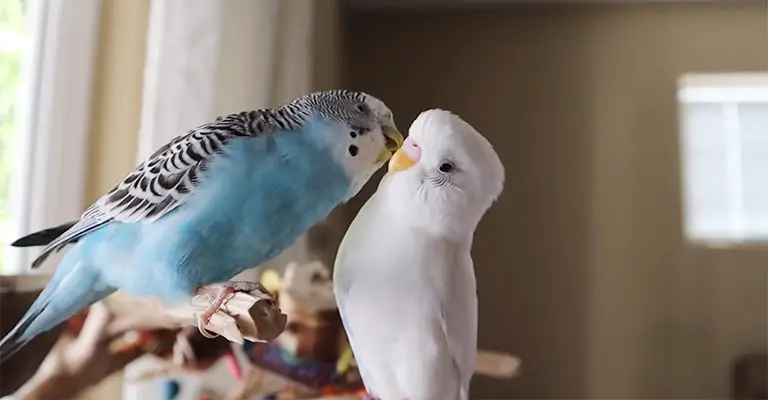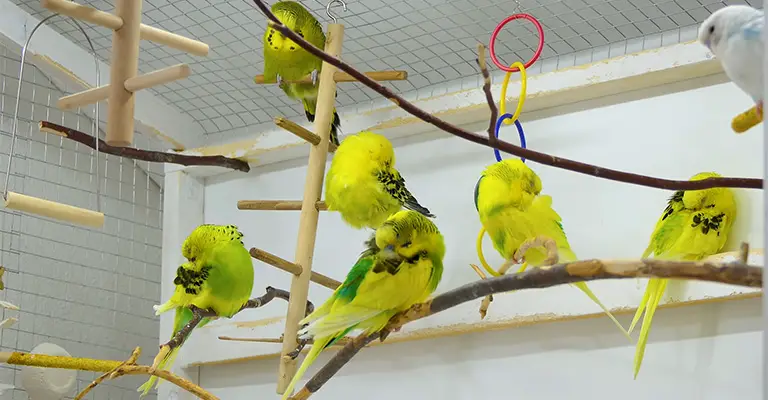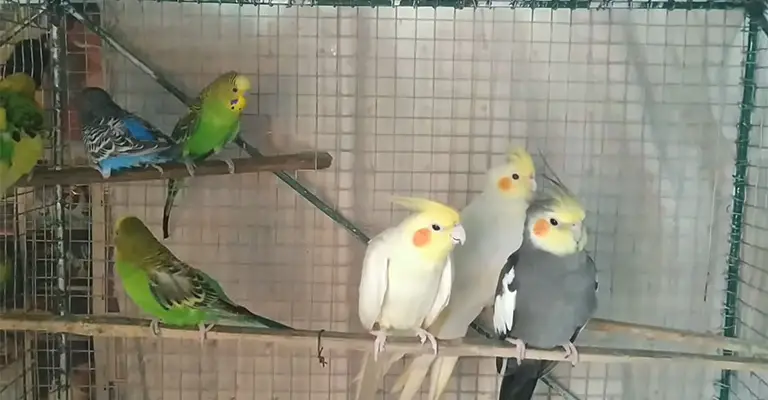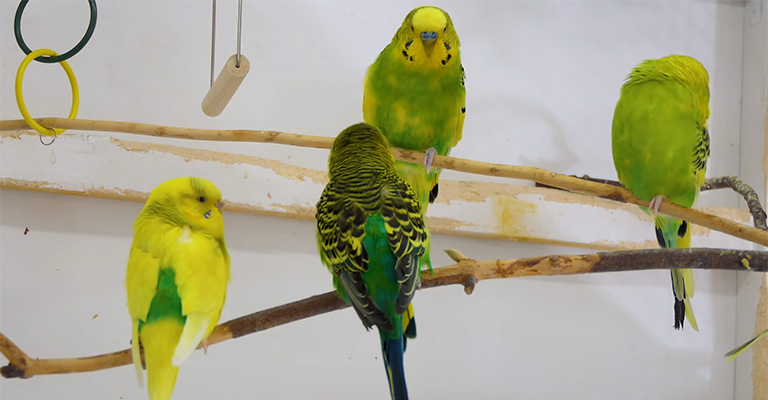The evening routine of covering your parakeets for bed is typically a peaceful and calming experience. However, if you’ve noticed your parakeets engaging in nipping behavior as you cover them, you might be left wondering about the reasons behind this unexpected behavior.
Parakeets, also known as budgies, are social and intelligent birds that communicate through various actions. Parakeets are complex creatures with their own ways of communicating and responding to their environment.
While nipping might seem peculiar during bedtime, it’s crucial to remember that parakeets have their unique ways of expressing themselves.
In this article, we’ll delve into ‘Why do my parakeets only nip at each other when I cover them for bed’. By gaining insight into their actions, you can better understand their needs and take steps to foster a peaceful and harmonious bedtime routine for both you and your feathered companions.

Why Do My Parakeets Only Nip at Each Other When I Cover Them for Bed?
Parakeets nipping at each other when being covered for bedtime could be attributed to a combination of factors:
Territorial Behavior
Parakeets can become territorial over their sleeping spots. When you cover them, they might perceive it as an invasion of their space, leading to defensive nipping to protect their area.
Low Light Sensitivity
Parakeets have excellent vision and are sensitive to light changes. Covering them abruptly might trigger a startle response, causing them to nip out of confusion or a mild fear reaction.
Communication
Nipping can be a form of communication among parakeets. They may be expressing their feelings or trying to establish dominance within their flock.
Playfulness
Nipping can sometimes be playful behavior, especially among young parakeets. Covering them may trigger excitement, leading to playful nips.
Reinforcement
If you inadvertently react when nipped (such as by recoiling or vocalizing), the parakeets might interpret it as attention. This positive reinforcement could encourage them to continue the behavior.
Adjustment Period
If you’ve recently introduced a new routine or started covering them, the nipping might be a temporary reaction to the change. Over time, they may become accustomed to the routine and exhibit the behavior less.
Health Considerations
It’s essential to rule out any potential health issues causing discomfort or pain that might trigger nipping behavior.
To address this behavior, cover the cage slowly to avoid startling them. Establish a predictable bedtime routine to help them anticipate and adapt to being covered.
Offer treats or soothing words when covering them to associate the process with positive experiences. Watch for patterns and triggers, and adjust their environment accordingly.
How to Stop Parakeets from Nipping at Each Other?

Stopping parakeets from nipping at each other requires patience, observation, and proactive measures to address the underlying causes of the behavior.
Here are the steps you can take:
Observe Their Interactions
Pay attention to when and why the nipping occurs. Note any patterns, triggers, or specific situations that lead to nipping. This will help you understand the context of their behavior.
Ensure Adequate Space
Provide ample space within their cage, including multiple perches, hiding spots, and food/water stations. This can help reduce territorial disputes and create a more harmonious environment.
Gradual Introduction
If you have introduced new parakeets or rearranged their living space, do so gradually. Sudden changes can disrupt their social dynamics and lead to nipping.
Offer Mental Stimulation
Boredom can contribute to nipping. Provide toys, puzzles, and interactive activities to keep their minds engaged and prevent excessive aggression.
Provide Distractions
Offer distractions like fresh branches, bird-safe chew toys, and foraging opportunities. These activities can redirect their energy and prevent them from focusing on nipping each other.
Separate if Necessary
If nipping becomes aggressive or one parakeet consistently targets another, consider temporary separation. Use a divider in the cage to give them a break from each other. Gradually reintroduce them once their behavior improves.
Reinforce Positive Behavior
Reward positive interactions and non-aggressive behavior with treats, praise, or gentle attention. This positive reinforcement can encourage them to engage in more desirable behaviors.
Consult an Avian Veterinarian
If nipping is excessive, persistent, or escalates into aggression, consult an avian veterinarian. Health issues can sometimes lead to behavioral problems, and a vet can rule out underlying medical causes.
Spend Quality Time
Engage in regular interaction with your parakeets outside the cage. Handling, talking, and bonding time with you can help reduce tension between them.
Seek Professional Advice
If nipping continues despite your efforts, consider seeking guidance from a certified bird behaviorist. They can provide tailored strategies to address the specific dynamics in your parakeets’ flock.
Remember, changing behavior takes time. Stay consistent, patient, and attentive to your parakeets’ needs. By creating a positive and enriching environment, you can help foster more harmonious interactions among your feathered friends.
Why Do You Cover Parakeets at Night?

Covering parakeets at night serves several purposes that mimic their natural environment and promote their well-being:
Simulating Natural Light Cycles
In the wild, parakeets experience natural light cycles. Covering them at night helps replicate the darkness they would encounter, allowing them to rest and recharge. This is important for maintaining their overall health and sleep patterns.
Reducing Stress and Stimulation
Covering the cage helps create a sense of security and reduces potential stressors from external noises, sudden movements, or changes in lighting. This helps parakeets settle down and have a more peaceful sleep.
Preventing Overstimulation
Parakeets are visually sensitive birds. Covering their cage prevents exposure to lights, screens, and other stimuli that might disrupt their sleep and circadian rhythms.
Encouraging Natural Sleep Patterns
Parakeets require proper sleep for their mental and physical well-being. Covering the cage promotes longer and more restful sleep, allowing them to wake up refreshed and energized.
Regulating Hormonal Cycles
In the wild, changes in daylight duration trigger hormonal shifts related to breeding and molting. Covering the cage helps regulate these hormonal cycles, preventing untimely breeding behaviors.
Establishing Routine
Creating a consistent bedtime routine helps parakeets anticipate rest. They become accustomed to the routine, making it easier for them to settle down at night.
Bonding and Social Interaction
Covering the cage also gives parakeet owners a chance to bond with their pets. As you approach the cage in the morning to uncover it, your parakeets may associate you with positive interaction and care.
Temperature Regulation
Covering the cage can help maintain a stable and comfortable temperature within the enclosure, ensuring your parakeets stay warm during the night.
When covering your parakeets at night, ensure that the cover is breathable and not too tight, allowing for proper airflow. Additionally, uncover the cage during the day to provide them with natural light and social interaction.
By incorporating these practices, you create a balanced routine that supports your parakeets’ physical and emotional well-being.
How Do You Know If Two Parakeets Like Each Other?

Determining if two parakeets like each other involves observing their behavior, interactions, and body language. Here are signs that indicate a positive relationship between parakeets:
Proximity and Closeness
If two parakeets are often found perched close to each other, preening each other’s feathers, or sleeping side by side, it’s a positive sign of their bond.
Mutual Preening
Mutual preening is a significant social behavior among parakeets. If you observe them grooming each other’s feathers, it indicates a level of trust and affection.
Playful Interactions
Playfulness, such as chasing each other around the cage or engaging in mock “fights,” shows that they enjoy each other’s company and are comfortable around each other.
Feeding Each Other
Regurgitating food and feeding it to each other is a sign of a close relationship. This behavior mimics courtship and bonding rituals.
Vocalizations
Happy and content parakeets often engage in soft chattering, chirping, and singing when they are around each other.
Sharing Perches
Parakeets that willingly share perches, especially when there’s enough space available, are showing that they are comfortable in each other’s presence.
Comfortable Body Language
Relaxed body postures, where they don’t appear tense or aggressive, indicate that they feel safe and at ease around each other.
Mutual Exploration
If they explore their environment together, investigate toys, or explore new additions to their cage as a pair, it suggests a shared sense of curiosity and comfort.
Sleeping Closely
If they sleep near each other, especially if they are tucked closely together, it’s a positive indication of their bond.
No Signs of Aggression
A lack of aggressive behavior, such as constant chasing, biting, or excessive territorial behavior, is a good sign that they have a positive relationship.
Keep in mind that parakeets are social birds, and they may form bonds and exhibit some of these behaviors even if they aren’t necessarily a breeding pair.
It’s essential to observe their interactions over time and consider multiple signs to assess their relationship accurately. If you’re introducing new parakeets, be patient and give them time to acclimate and establish their social dynamics.
FAQs
Absolutely. Parakeets of the same gender can form strong bonds and exhibit behaviors like preening, playing, and perching closely together. The strength of their bond is more about their personalities and interactions than their gender.
While parakeets are social birds, individual personalities play a role in how well they get along. Some pairs may become fast friends, while others might need more time to adjust to each other’s presence.
Introduce new parakeets gradually in neutral territory. Observe their interactions and monitor for signs of aggression or stress. It’s recommended to quarantine the new bird initially and consult with experts if needed.
Parakeets are generally more likely to form strong bonds with their own kind due to shared behaviors and communication. While they might interact with other bird species, forming a close bond is less common.
If your parakeets show signs of aggression, excessive fighting, or stress, consider giving them more space or temporarily separating them. Gradually reintroduce them, offer separate food and water stations, and observe their interactions closely.
Conclusion
While parakeets nipping at each other when being covered for bedtime might initially raise concerns, it’s important to approach this behavior with a balanced perspective.
The nipping behavior could stem from a range of factors, such as territorial instincts, playfulness, or even a desire for attention.
As responsible parakeet owners, it’s crucial to observe their interactions, body language, and overall behavior to decipher the underlying reasons behind their actions.
By establishing a consistent and calming bedtime routine, creating a comfortable sleeping environment, and offering opportunities for mental and physical stimulation during the day, you can gradually help reduce or redirect nipping behavior.
Remember that patience, understanding, and positive reinforcement are key to fostering a harmonious relationship with your parakeets.
As you work towards building trust and connection, you’ll likely find that bedtime becomes a peaceful and enjoyable part of your parakeets’ daily routine.